Satellite broadcasting service

* Earth station
* Feed connection (uplink)
* Space station
* Receiving antenna, LNB, and SAT receiver
Broadcasting satellite service ( English - broadcasting-satellite service [BSS] ) is - in accordance with Article 1:39 of the ITU Radio Regulations (Radio Regulations) of the International Telecommunication Union (ITU) - defined as
- “A) Radio service in which the signals transmitted or transmitted by space stations are intended for direct reception by the general public and which may include audio broadcasts, television broadcasts or other types of broadcasts, and
- b) radio service whose radio usages have the essential technical characteristics of the radio usages under letter a; the radio uses under letter a enjoy priority. " .
classification
The VO Funk categorizes this radio service as follows:
-
Broadcasting service (Article 1.38)
- Satellite broadcasting service (Article 1.39)
In addition to the receivers required to receive the television radio programs, earth stations and space radio stations are generally used in this radio service .
- Hardware broadcasting service via satellite
Earth station BSS
Frequency allocation
The allocation of certain frequency ranges to this radio service takes place in accordance with Article 5 of the Radio Regulations (2012 edition). For the most economical, efficient and harmonized use of frequencies, these frequency assignments are available on a non-discriminatory basis in the responsibility of the relevant frequency administration (sovereign and authorities) in national plans and ordinances. Assignments can be primary, secondary, exclusive or sharpened. Primary assignments are usually made for this radio service.
- Primary assignment = representation with UPPER CASE (see example representation)
- Secondary assignment = representation in lower case / normal notation
| Assignment to radio services | ||
| Region 1 | Region 2 | Region 3 |
| 1 452–1 492 MHz FIXED RADIO SERVICE MOBILE RADIO SERVICE except for mobile aeronautical radio service BROADCASTING SERVICE BROADCASTING SERVICE VIA SATELLITES |
1,452-1,492 FIXED RADIO |
|
| 2 520–2 655 FIXED RADIO SERVICE MOBILE RADIO SERVICE except for mobile aviation radio service BROADCASTING SERVICE VIA SATELLITES |
2 520–2 655 FIXED RADIO SERVICE FIXED RADIO SERVICE VIA SATELLITES (in the direction of space-earth) MOBILE RADIO SERVICE except for mobile aeronautical service BROADCASTING SERVICE VIA SATELLITES |
2 520–2 535 FIXED RADIO SERVICE FIXED RADIO SERVICE VIA SATELLITES (in the direction of space-earth) MOBILE RADIO SERVICE except mobile aeronautical service BROADCASTING SERVICE VIA SATELLITES |
| 2 535–2 655 FIXED RADIO SERVICE MOBILE RADIO SERVICE except for mobile aviation radio service BROADCASTING SERVICE VIA SATELLITES |
||
| 2 655–2 670 FIXED RADIO SERVICE MOBILE SERVICE except mobile aeronautical service BROADCASTING VIA SATELLITES Earth exploration service via satellites (passive) Radio astronomy radio service Space research service (passive) |
2 655–2 670 FIXED RADIO SERVICE FIXED RADIO SERVICE VIA SATELLITES (in the direction of space-earth) MOBILE SERVICE except mobile aeronautical service BROADCASTING SERVICE VIA SATELLITES Earth exploration service via satellites (passive) Radio astronomy service via space research service (passive) |
|
| 11.7–12.5 GHz FIXED RADIO SERVICE MOBILE RADIO SERVICE except for mobile aircraft radio service BROADCASTING SERVICE BROADCASTING SERVICE VIA SATELLITES |
12.2-12.7 FIXED WIRELESS SERVICE MOBILE SERVICE except aeronautical mobile service BROADCASTING SERVICE BROADCASTING SERVICES SATELLITE |
11.7–12.2 FIXED RADIO SERVICE MOBILE RADIO SERVICE except for mobile aircraft radio service BROADCASTING SERVICE BROADCASTING SERVICE VIA SATELLITES |
| 12.5–12.75 FIXED RADIO SERVICE FIXED RADIO SERVICE VIA SATELLITES (in the direction of space-earth) MOBILE RADIO SERVICE except for mobile aeronautical service BROADCASTING SERVICE VIA SATELLITES |
||
| 17.3–17.7 FIXED RADIO SERVICE VIA SATELLITES (direction space-earth) BROADCASTING SERVICE VIA SATELLITES Non-navigational location radio service |
||
| 17.7–17.8 FIXED RADIO SERVICE FIXED RADIO SERVICE VIA SATELLITES (Direction Space-Earth) (Direction Earth-Space) BROADCASTING SERVICE VIA SATELLITE Cellular service |
||
| 21,4–22 FIXED RADIO SERVICE MOBILE RADIO SERVICE BROADCASTING SERVICE VIA SATELLITES |
21,4–22 FIXED RADIO SERVICE MOBILE RADIO SERVICE BROADCASTING SERVICE VIA SATELLITES |
|
| 40,5–41 FIXED RADIO SERVICE FIXED RADIO SERVICE VIA SATELLITES (towards space-earth) BROADCASTING SERVICE BROADCASTING SERVICE VIA SATELLITE |
40.5–41 FIXED RADIO SERVICE FIXED RADIO SERVICE VIA SATELLITES (direction space-earth) BROADCASTING SERVICE VIA SATELLITES Mobile radio service Mobile radio service via satellites (direction earth-space) |
40,5–41 FIXED RADIO SERVICE FIXED RADIO SERVICE VIA SATELLITES (direction space-earth) BROADCAST SERVICE VIA SATELLITES Cellular service Cellular service |
| 41-42.5 FIXED RADIO |
||
See also
Web links
Individual evidence
- ↑ Green Paper - Frequency range allocation plan for the Federal Republic of Germany and international allocation of the frequency ranges 9 kHz - 400 GHz; 1994; issued by the BMPT; BAPT order no. 5010311 001-1; Page 11, No. 37_3.18, definition: broadcasting service via satellite.
- ^ VO Funk, Edition 2012, Article 1.39, Definition: Broadcasting-satellite service
- ↑ International regulations on the allocation of frequencies in accordance with the Implementing Regulations for the Radio Service (VO Radio) of the International Telecommunication Union (ITU), CHAPTER II - Radio frequencies, ARTICLE 5 Frequency range allocation, Section IV - Table frequency range allocation







